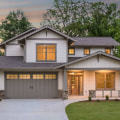Roof pitch, the angle or slope of a roof, is one of the most influential yet often overlooked factors in home building. It affects everything from the durability of the structure to the way the home interacts with the environment. A steep roof pitch is commonly chosen in regions with heavy rainfall or snow, allowing water and debris to slide off easily, while lower pitches are more popular in modern designs that emphasize minimalism and flat planes. Beyond aesthetics and functionality, roof pitch plays a surprisingly important role in the home’s overall energy efficiency, directly influencing heating, cooling, and ventilation performance.
Thermal Regulation Through Roof Slope
The angle of a roof has a direct impact on how heat is absorbed and retained by a home. A low-pitched or flat roof can absorb more direct sunlight for longer periods, which may increase indoor temperatures, especially in warmer climates. On the other hand, steeper pitches often reduce solar heat gain by reflecting sunlight at different angles, helping to keep the structure cooler during hot months. In colder regions, specific roof pitches can be optimized to prevent heat loss by reducing surface exposure, striking a balance between insulation and natural thermal performance.
Ventilation Benefits of Proper Pitch
Energy efficiency is not just about insulation and heat gain—it’s also about airflow. Roof pitch affects attic space and ventilation, which in turn influences the efficiency of heating and cooling systems. Steeper pitches create larger attic cavities, allowing for better air circulation and more room for insulation materials. This enhanced ventilation reduces the buildup of heat in summer and minimizes condensation in winter, both of which protect the integrity of the home and lower energy costs. A well-planned roof pitch thus helps balance indoor climates throughout the year without overburdening mechanical systems.
Solar Panel Optimization and Roof Pitch
For homeowners investing in renewable energy, roof pitch becomes even more critical. The angle of the roof dictates how effectively solar panels can capture sunlight. A pitch that aligns with the optimal angle for the region’s latitude ensures maximum energy absorption, reducing reliance on traditional utilities. Conversely, poorly aligned roofs may require additional mounts or adjustments to achieve efficiency, which increases costs. Integrating the right pitch during the building stage makes solar energy systems more productive and cost-effective in the long run.
Material Longevity and Energy Savings
The pitch of a roof also influences how long materials last, which indirectly affects energy efficiency. Flat or low-pitched roofs tend to retain water, debris, and snow, leading to quicker wear and tear. When materials degrade prematurely, gaps and leaks allow air and moisture intrusion, reducing insulation performance and driving up energy costs. A steeper pitch naturally sheds water and debris, extending the lifespan of materials and preserving energy performance. Just as homeowners count on Brisco Roofing to ensure durability and long-term performance, carefully considering roof pitch during construction ensures that the building envelope remains resilient and energy efficient.
Conclusion: Pitch as a Path to Efficiency
Roof pitch is more than an architectural preference—it is a fundamental factor in energy efficiency. From regulating thermal gain and enhancing ventilation to optimizing solar potential and prolonging material life, the angle of the roof has far-reaching implications for comfort, cost savings, and sustainability. By incorporating the right pitch during the planning and building phases, homeowners set the stage for a home that performs efficiently for decades to come, blending form, function, and long-term energy benefits.



